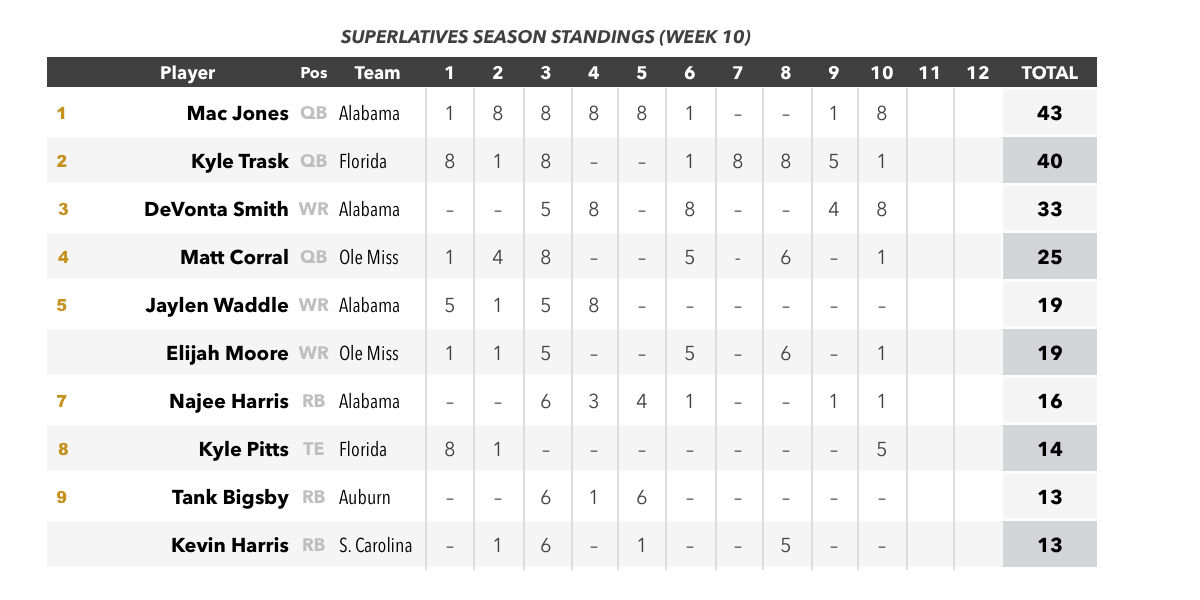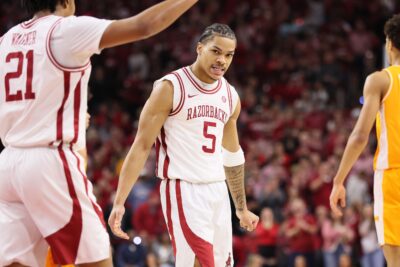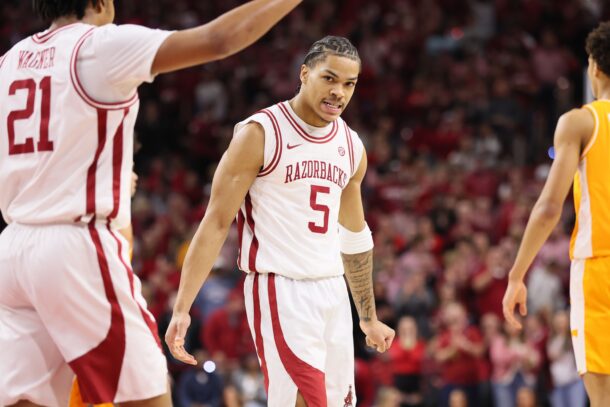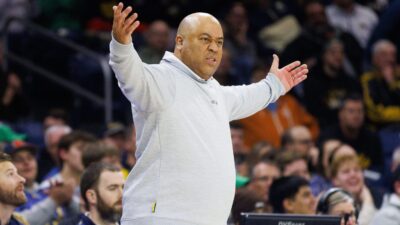
Monday Down South: DeVonta Smith stakes his claim as Alabama’s greatest wideout. Ever
By Matt Hinton
Published:
Weekly takeaways, trends and technicalities from the weekend’s action.
DeVonta Smith is an all-timer
Alabama 42, Auburn 13. On its own, nothing about Smith’s show-stopping, 171-yard, 2-touchdown romp in the Iron Bowl was any kind of revelation. By his standards, it was more like just another day at the office: His 10th career outing over 100 yards, his 8th with multiple TDs, his 7th averaging 20+ yards on at least 3 receptions. You know, just clocking in. He already owned the SEC record for career receiving touchdowns, set last week vs. Kentucky; after Saturday, he’s accounted for more TDs in the last six games alone (11) than Alabama’s leading receiver in 9 of Nick Saban’s first 11 seasons as head coach, and as many as the 2008 team had for the entire year. What could one more over-the-top outing possibly tell us that we didn’t already know?
In case you didn't know, Devonta Smith is ridiculously fast. pic.twitter.com/zr53vWef6D
— CBS Sports (@CBSSports) November 28, 2020
All-American? A no-brainer. Biletnikoff? The clear favorite. Draft stock? On the rise. At this point, there’s really only one question still worth asking: Is Smith Alabama’s best receiver ever?
Steep competition, to say the least – especially for a player who, as clutch as he was early in his career and as prolific as he’s proven to be over the long run, has only lately emerged as clearly the best receiver on his own team. At first glance, Smith has never looked the part; his rail-thin, 175-pound frame is a far cry from the freakish, NFL-ready physicality of Julio Jones, or even the less imposing sturdiness of Amari Cooper. His best efforts in this COVID-shortened season are destined to come up short of threatening Cooper’s Heisman-worthy totals in 2014. He’s not quite as fast as Henry Ruggs III, not quite as smooth as Jerry Jeudy, not quite as electric with the ball in his hands as Jaylen Waddle. On arguably the fastest, smoothest, most electric receiving corps ever assembled on the college level, somebody has to be The Other Guy.
From the start, though, Smith kept on showing up. As a true freshman, he was the target on a game-winning, season-saving touchdown at Mississippi State and later on the receiving end of the single most important pass in Bama history. Over the next 2 years, he averaged nearly 18 yards per catch with 20 touchdowns, or one every 5.5 touches. He singlehandedly roasted Derek Stingley Jr. last November in a performance that will resonate for years after Stingley becomes a household name at the next level. This year, with Jeudy and Ruggs gone, Smith has thrived as a well-rounded headliner; in the weeks since Waddle left the lineup with a broken ankle, he has elevated his game to a new level.
The man has had a career, in other words. Fittingly, his major claims on the record book cover the full span of Alabama’s evolution into a spread-passing juggernaut. In addition to the career touchdown record, Smith is less than 300 yards away from Cooper’s school record for career receiving yards (3,463), a mark he’ll likely break over the next 2 to 3 weeks on fewer receptions than Cooper, and less than 600 yards away from the SEC record belonging to Vanderbilt’s Jordan Matthews. With at least 4 and possibly 5 games left to play (the possible 5th being the national championship game) that mark is a very real possibility. At his current pace, it may as well be a foregone conclusion.
Yet unlike most of the other contenders for the title, Smith’s rise on the short list of all-time Bama wideouts never felt preordained. Looking back, maybe it should have. Every step of the way he’s made it clear that he belongs in that discussion, and now that the time has come to have it he’s not going anywhere. His star only continues to rise.
Texas A&M still has a lot to prove
Texas A&M 20, LSU 7. Not to dismiss the rectitude of a 13-point win over the defending national champs, particularly when A&M was less than a minute away from 1) a shutout, and 2) covering the 14.5-point spread before LSU tacked on an otherwise meaningless score at the end of regulation. But this was the Aggies’ first game as full-fledged, committee-approved Playoff contenders, and whatever doubts existed about their status before Saturday night, they still exist.
Given a primetime opportunity against one of the SEC’s most combustible defenses, A&M’s offense wilted: 16 offensive possessions yielded 12 punts, 7 3-and-outs, 2 field goals, a turnover on downs inside the LSU 20-yard line, and a lone touchdown, courtesy of a 52-yard run by RB Isaiah Spiller late in the first quarter. (The Aggies’ only other TD came on a pick-6 forced by the defense in the second half.) Stuck with a limited and largely unproven bunch of receivers, QB Kellen Mond completed a dismal 11-of-34 attempts with a long gain of 18 yards, turning in his worst passer rating of the season (58.3) in what may have been his final home game at Kyle Field. Altogether, A&M eked out just 267 yards, easily a season-low, on fewer yards per play (3.8) than any other offense has managed vs. LSU this year.
The silver lining, for what it’s worth, was the defense, which thoroughly whipped LSU along the line of scrimmage and overwhelmed the Tigers’ rotating freshman QBs, TJ Finley and Max Johnson. That’s the 3rd time in the last 4 games the Aggies have held an opposing offense to a touchdown or less on well below 300 total yards. The others: Mississippi State and South Carolina. Yeah.
At the end of the night, A&M’s Playoff path remained the same as it did on Saturday morning: At No. 5 in the committee rankings, the Aggies are essentially banking on chalk in the ACC (Notre Dame over Clemson) and SEC (Alabama over Florida) to ensure the Tigers’ and Gators’ elimination and claim the 4th spot for themselves. (If Clemson and/or Florida happen to win those games, then presumably ND and/or Bama will bump A&M out.) Besides taking care of their own business down the stretch against Auburn and Tennessee, though, A&M also has to be concerned with the dreaded eye test: Is winning ugly good enough to get by, or is the committee willing to elevate, say, undefeated Cincinnati above the Aggies if the product remains as sloppy as it was against LSU? Auburn and Tennessee are both mediocre outfits with little cachet at the moment outside of name recognition — i.e. teams an aspiring Playoff contender should beat soundly. (See: Alabama.) A&M doesn’t control its own destiny, but it does control how well it plays over the next two weeks in two imminently winnable games that it has to have. Their goal should be to not leave anything up to the whims of the committee.
Derek Mason never stood a chance
Missouri 41, Vanderbilt 0. It’s debatable whether Derek Mason ever really stood a chance of making it to 2021, especially after the revised conference-only schedule all but assured Vanderbilt of a winless season. If he did, though, it was going to be on the basis of a team that at least looked remotely competitive in the process, and this team has been anything but.
The 41-point margin in Colombia marked Vandy’s worst loss vs. an unranked opponent in a decade and its 4th this year by 30+ points. Emergency kicker Sarah Fuller, whose presence on the traveling roster generated more national attention than Vanderbilt football has enjoyed in ages, was limited to the 2nd-half kickoff because the offense failed even to enter plausible field-goal range.
Losing was a given. But the difference between a feisty outfit building for the future behind true freshman QB Ken Seals and a stagnant, shorthanded squad just playing out the string was too obvious to ignore. Mason goes out with a 27-54 record over 7 years (10-46 in SEC play), good for the 4th-best winning percentage at Vandy in his lifetime.
God bless and stay safe. ????#AnchorDown pic.twitter.com/zrvpTPaGyb
— Derek Mason (@CoachDerekMason) November 29, 2020
Is it fair to expect more from the next guy? Outside of Mason’s predecessor, James Franklin (24-15 from 2011-13), no head coach has made it out of Nashville with a winning overall record in more than 40 years; since SEC expansion in 1992 only Franklin and Bobby Johnson (7-6 in 2008) have managed so much as a winning season. Academic realities are what they are; commitment from the university is a different question. Facilities are notoriously out of step with the rest of the SEC – planned upgrades are reportedly in limbo due to some combination of COVID-19 and administrative ambivalence – to the extent that when Florida visited a few weeks back the Gators arrived deliberately late to the stadium and remained on the field during halftime in order to avoid the visitors’ locker room.
This is one of those perennially hopeless situations that often inspires people to suggest, half-jokingly, that the new staff should say the hell with it and embrace the triple option.
Seriously, though: Vanderbilt should embrace the triple option.
The service academy model is a perfect fit for Vandy’s academically limited recruiting profile, and Paul Johnson’s 2008-18 tenure at Georgia Tech – a very similarly situated program, recruiting-wise – is a blueprint for building a competitive culture in a Power 5 conference with 3-star talent. (Johnson’s .580 winning percentage in Atlanta ranks No. 2 among full-time Tech coaches since 1970.) Johnson himself is available, although not necessarily interested in coming out of retirement at 63 for a literal rebuilding job; someone like Tulane’s Willie Fritz, who has an option background and a solid track record at the JUCO, FCS and Group of 5 levels, might be a more viable target.
At any rate, the name at the end of the process is not as important as establishing a sustainable identity other than “doormat.” If nothing else, at least the option is a stable foothold for competing against Kentucky, Missouri, Ole Miss and South Carolina that the right coach can sell to attainable recruits year after year. And if it doesn’t work out, well, what else is new? No program in America right now has less to lose.
There’s no one else like Kyle Pitts
Florida 34, Kentucky 10. Kyle Pitts may not be a Heisman candidate – no tight end has cracked the top 10 in Heisman voting since 1977 – but he is the most unique athlete in college football. Watch the first of his 3 touchdowns in Florida’s win over Kentucky and ask yourself: Who does this guy remind me of?
Welcome back, Kyle Pitts ? pic.twitter.com/hnLPhtCxUI
— SEC Network (@SECNetwork) November 28, 2020
Pitts’ most obvious asset, his jump-ball prowess against smaller DBs, is well documented. (Kentucky got a taste of that, as well.) But that catch-and-run, covering 56 yards, is easily the best example yet of his pure, preposterous speed at 6-6, 240 pounds.
Consider that the guy covering him on that play, LSU transfer Kelvin Joseph, is a former blue-chip prospect with a near-certain NFL future coming off a stellar performance against Alabama in which he didn’t allow a catch. At 6-1/192, Joseph is one of the handful of SEC corners who might reasonably be expected to hang with Pitts 1-on-1 – or at least he was, anyway. Instead, Pitts left him grasping for air at the point of attack and two steps behind for the remaining 40 yards to the end zone, a distance he covered in (by my stopwatch) roughly 4.6 seconds. Feel free to time it up yourself.
So again: What other 6-6, 240-pound contested-catch specialist with universal first-round hype and cornerback-dusting wheels in the open field comes readily to mind there? Because me, I’m not coming up with many hits.
We can only speculate about Pitts’ actual size/strength/speed measurements until next year’s NFL Combine, health and pandemic willing. But for the sake of argument, let’s go with his listed height/weight and (conservatively, I think) a 4.60 40-yard dash. Here’s the complete list of tight ends who clocked a combine 40 of 4.60 or better at 6-6, 240 pounds or heavier since 1990:
• 2005 – Matt Jones, Arkansas (4.38 at 6-6/242)
• 2008 – Kellen Davis, Michigan State (4.59 at 6-6/262)
• 2010 – Jimmy Graham, Miami (4.53 at 6-6/260)
• 2012 – Coby Fleener, Stanford (4.52 at 6-6/247)
• 2017 – Bucky Hodges, Virginia Tech (4.57 at 6-6/257)
That’s it. Jones (a 1st-round pick) and Graham (3rd round) were projects transitioning from quarterback and basketball, respectively, on raw potential alone; Davis (5th) and Hodges (6th) were much less touted. Fleener, a 2nd-rounder who went on to a solid pro career after earning an All-America nod at Stanford, might be the closest match on paper but doesn’t exactly evoke the image of a singular athletic specimen.
Here’s a name that might work: Chase Claypool. At 6-4, 238 pounds, Claypool fits easily into the hybrid WR/TE mismatch role that Pitts is in the process of redefining; he made more than his share of highlight-reel catches at Notre Dame, and his output over his last two years there was remarkably similar to Pitts’ production at Florida. At the combine, he joined Calvin Johnson as the only wideouts ever to post a sub-4.45 40 time (a 4.42, in Claypool’s case) after weighing in at 6-4/235 or bigger. As a rookie, he’s already the Pittsburgh Steelers’ leader in receiving yards, yards per catch and touchdowns.
Claypool wasn’t as decorated as he should have been at ND and was a steal in Round 2. Pitts won’t have to wait nearly that long. For now, at the college level, the man is as close to a one-of-a-kind player as we’ve seen in a long time.
Superlatives
The best of the week.
1. Alabama QB Mac Jones and WR DeVonta Smith. Jones hung 302 yards and 5 touchdowns on Auburn on just 26 attempts, good enough for his 2nd-best passer rating of the season (230.3) and to keep him just in front of BYU’s Zach Wilson and Ohio State’s Justin Fields for the national lead in efficiency. More than half of those yards came via Smith (7 for 171 yards, 2 TDs), who has gone over 100 yards now in 4 of the last 6 games with no sign of slowing down.
2. LSU CB Derek Stingley Jr. and Alabama CB Malachi Moore. Stingley hasn’t enjoyed the easy All-America campaign he was supposed to, in large part due to injuries, but he looked like his old, inescapable self in LSU’s loss to Texas A&M, allowing just 1 catch for 5 yards with 3 PBUs on 6 targets. Along with sophomore Cordale Flott (8 tackles, 2 PBUs), the Tigers’ corners played leading roles in limited A&M to just 105 yards and 5 first downs passing.
Sharing the No. 2 spot this week is Moore, a true freshman who has quickly carved out a permanent role in Bama’s secondary that he figures to occupy for the foreseeable future. Against Auburn, he was targeted 6 times, allowed just 1 catch for 7 yards, and came away with his 3rd interception of the year.
NEVER throw it late to the sideline
Great break and play by Malachi Moore (aka the next great Alabama DB) pic.twitter.com/qn4AHt7nPE
— Cam Mellor (@CamMellor) November 28, 2020
3. Florida TE Kyle Pitts. Pitts finished with 5 receptions for 99 yards against Kentucky in his first game back from an extended, concussion-related absence, including all 3 of Kyle Trask’s weekly allotment of touchdowns. The next team to hold him in check this season without committing an egregious targeting penalty will be the first.
4. Georgia’s Offensive Line. The Bulldogs rebounded from an abysmal rushing performance against Mississippi State with a dominant effort at South Carolina, with 4 backs (James Cook, Zamir White, Kenny McIntosh and Daijun Edwards) combining to run for 344 yards and 4 touchdowns on 8.2 per carry in a lopsided, 45-16 win. UGA scored on 7 of its first 9 offensive possessions and used the 10th, mercifully, to drain the final 9:27 off the clock.
5. Texas A&M DL DeMarvin Leal and LB Aaron Hansford. Leal and Hansford led the charge on a dominant night for A&M’s front seven, combining for 12 tackles, 3 TFLs and 4 QB hurries in the Aggies’ win over LSU. Hansford was responsible for possibly the biggest play of the game, supplying the hit on TJ Finley that forced him into throwing the game-icing pick-6 into the waiting arms of LB Buddy Johnson.
Honorable Mention: Texas A&M RB Isaiah Spiller, who went off for 141 yards on 27 carries vs. LSU, including a 52-yard TD in the first quarter that stood as A&M’s only offensive touchdown. … Missouri RB Larry Rountree III, who ran for 160 yards and 3 TDs on 7.6 per carry in the Tigers’ blowout win over Vanderbilt. … Alabama RB Najee Harris, who went over 100 yards from scrimmage for the 6th consecutive game with 96 rushing and 34 receiving in the Tide’s win over Auburn. … Alabama LBs Christopher Allen and Will Anderson Jr.,who combined for 8 tackles, 4 TFLs and 4 QB hurries off the edge. … Missouri LB Nick Bolton, who had 9 tackles, 2 TFLs, and a sack in a shutout effort vs. Vandy. … Florida LBs James Houston IV and Mohamoud Diabate, who combined for 14 tackles, 4 TFLs, 2 QB hurries, and an interception (by Diabate) in the Gators’ win over Kentucky. … South Carolina TE Nick Muse, who set career highs for catches (8) and yards (131) in the Gamecocks’ loss to Georgia and hauled in his first career touchdown. … Ole Miss QB Matt Corral, who lit up Mississippi State’s secondary for 385 yards and 2 TDs on 24-of-36 passing in the Rebels’ 31-24 win in the Egg Bowl. … Ole Miss WR Elijah Moore, whose 12 catches for 139 yards vs. the Bulldogs moved him past A.J. Brown for the single-season school record for receptions with 86 in just 8 games. … Mississippi State QB Will Rogers, who turned in a proper Air Raid outing in Oxford with 440 yards and 3 TDs on 61 attempts. … And Mississippi State WR Jaden Walley, who continued his November emergence with 9 receptions for 176 yards, including the catch of the week on the Bulldogs’ final drive.
– – –
The scoring system for players honored in Superlatives awards 8 points for the week’s top player, 6 for 2nd, 5 for 3rd, 4 for 4th, 3 for 5th and 1 for honorable mention because how honorable is it really if it doesn’t come with any points? The standings are updated weekly with the top 10 players for the season to date.

Matt Hinton, author of 'Monday Down South' and our resident QB guru, has previously written for Dr. Saturday, CBS and Grantland.






